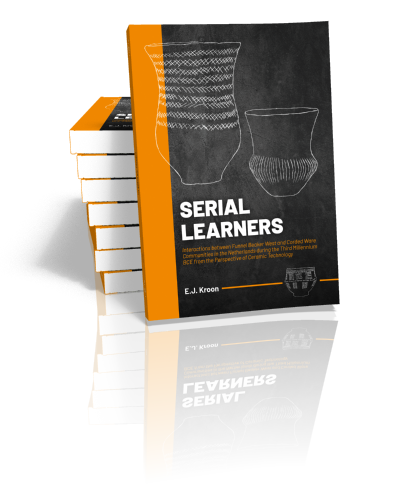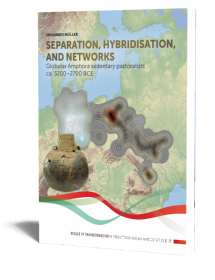Abstract:
5,000 years ago, a migration shaped Europe’s future. Migrating communities spread across Europe within two centuries, leaving lasting changes in interconnectivity, language, and ancestry. Yet these migrating communities did not enter an empty continent. Across Europe, they encountered indigenous communities with millennia-old roots. What interactions between migrating and indigenous communities gave rise to those lasting changes?
This study sheds new light on this question with an innovative approach to ceramics. Ceramics bear traces of the production techniques which potters learned and applied to create them. The approach developed here combines a chaîne opératoire analysis of these traces with network analysis and probability theory to provide a quantitative estimate of the amount of shared knowledge between the prehistoric potters who made these ceramics.
This approach is applied to ceramics from migrating Corded Ware communities and indigenous Funnel Beaker West communities in the Netherlands. The aim is to detect whether potters in these communities interacted and shared knowledge. The outcomes offer a unique perspective on this period and prehistoric migrations in general. Migrating and indigenous communities are shown to co-exist for several centuries at the start of the third millennium BCE with evidence for migrant potters learning repeatedly from indigenous potters and incorporating this knowledge into the production of Corded Ware vessels.
Contents
1 Beakers, Plagues, and Battle Axes
1.1 A Very Short Introduction to the Third Millennium BCE
1.2 Three Answers, One Problem
1.3 Migration: A Link Between Scales
1.4 Thinking with Ceramics
1.5 Research Question and Study Area
1.6 The Third Millennium BCE: A Matter of Concern
1.7 Outlook
2 Funnel Beaker West and Corded Ware Communities Co-existed
2.1 The Age of Ceramics
2.2 Rise and Fall
2.3 Re-examining the Absolute Chronology of the Third Millennium BCE
2.4 Funnel Beaker West Chronology: What Can We Know?
2.5 Funnel Beaker West in the Third Millennium BCE
2.6 Overview
3 An Archaeology of Learning
3.1 Beyond Group Detection
3.2 From Sherds to Learning
3.3 Overview
4 A Probabilistic Analysis of Ceramic Technology
4.1 The Chaîne Opératoire as a Network
4.2 The Total Chaîne Opératoire as a Probability Space
4.3 Final Considerations: Why Go Probabilistic?
5 Sample Design
5.1 Sampling Strategy
5.2 Analytical Techniques
5.3 Selected Vessels and Samples
5.4 Overview
6 Funnel Beaker West Ceramic Technology
6.1 Prior Studies
6.2 Specific Chaînes Opératoires in the Funnel Beaker West Body of Knowledge
6.3 Summary
7 Corded Ware Ceramic Technology
7.1 Previous Studies
7.2 Specific Chaînes Opératoires in the Corded Ware Body of Knowledge
7.3 Summary
8 Petrography of Funnel Beaker West and Corded Ware Vessels
8.1 Fabric Groups
8.2 Traces of Techniques
8.3 Provenance
8.4 Final Remarks
9 Abductive Comparison of Specific Chaînes Opératoires
9.1 Abductive Comparison
9.2 Are There Specialised Production Methods?
9.3 Discussion and Conclusion
10 Probabilistic Comparison of Specific Chaînes Opératoires
10.1 Probabilistic Comparison of Funnel Beaker West and Corded Ware
10.2 Expanding the Scope of the Comparisons
10.3 Summary
11 On the Origins of Neolithic Ceramic Technology
11.1 The Roots of Middle and Late Neolithic Ceramic Technology
11.2 Final Remarks
12 Here to Stay: Indigenous Communities in the 3rd Millennium BCE
12.1 Reports of Funnel Beaker Wests’ Death Are Greatly Exaggerated
12.2 Learning Prevails
12.3 Revising the Neolithic of Northwest Europe
13 Eager for Knowledge: Migrants in the Third Millennium BCE
13.1 Migrants Learned from Indigenous Communities…
13.2 …On More than One Occasion
13.3 Concluding Remarks
14 Conclusion
14.1 Setting the Stage
14.2 Business as Usual
14.3 Serial Learners
14.4 History of Knowledge: A New Synthesis
Bibliography
Appendices
Nederlandstalige Samenvatting
English Summary

Dr.
E.J. Kroon
Erik Kroon is a researcher at the Faculty of Archaeology, Leiden University where he obtained both his Bachelor’s and Master’s degree. His research foci are the Prehistory of Northwest Europe, in particular during the Late Neolithic, ceramic technology, and network analysis. He has also worked as Finds Advisor Prehistory in the project Portable Antiquities of the Netherlands and as researcher in the projects Economies of Destruction and The Talking Dead.
read more











